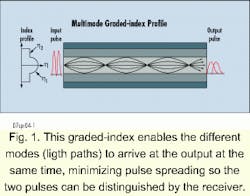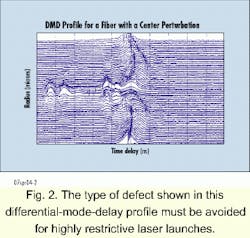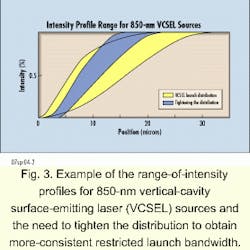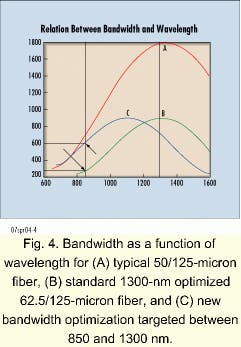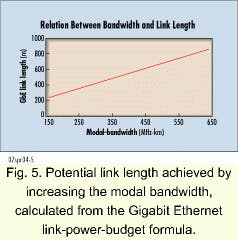Multimode fiber for Gigabit Ethernet laser applications
With data traffic growing at nearly 1000% per year, system designers are scrambling to achieve higher and higher bit rates. It's not surprising that with this growth rate, discussions have already begun on the next generation of Gigabit Ethernet, 10-Gigabit Ethernet, even though some of the issues surrounding the first Gigabit Ethernet standard approved under IEEE 802.3z in June 1998 have yet to be resolved.
Multimode fiber (MMF) is the dominant choice for local area networks (LANs) and fiber-to-the-desk. The fiber's ability to operate efficiently at the 850-nm window accounts for its choice. This ability enables the use of lower-cost sources, receivers, and connectors in the network, due in part to multimode fiber having a wide acceptance angle or numerical aperture.
Achieving higher data-transmission rates at short wavelengths, however, is no longer feasible with standard light-emitting-diode (LED) technology. LEDs, which transmit a signal over a relatively wide spectral band, are incapable of the high-speed modulation required for next-generation systems. Their relatively broad spectral width limits the distance a signal can be transmitted due to chromatic-dispersion effects within the fiber.
The only solution seemed to lie in laser technology. But standard edge-emitting lasers such as those used in long-haul singlemode links are expensive and have disadvantages when used in multimode systems. Thus, the advantage of multimode fiber (MMF) systems for short-haul applications seemed to be diminishing, as standard laser sources need to be implemented to achieve the necessary transmission rates for Gigabit Ethernet and beyond.
A new technology, however, has revived the short-wavelength potential for 62.5-micron MMF systems. Vertical-cavity surface-emitting lasers (VCSELs) have many of the advantages of singlemode lasers but at the cost and size of LEDs. Although VCSELs have provided the potential means to achieve higher bit rates at the short-wavelength window, they call into question the traditional methods of characterizing a fiber's information-carrying capacity-namely, its bandwidth.
Although system designers are ultimately interested in the link length and bit rate of a system, fiber manufacturers typically speak of bandwidth in their specifications. Bandwidth is the parameter that defines the information-carrying capacity of a fiber. In essence, it is a measure of the distortion that occurs to a pulse of light traveling along a fiber as it is broadened to a point where two separate pulses can no longer be distinguished by the receiver.
The total bandwidth is actually a combination of both modal and chromatic effects:The modal bandwidth is the value typically reported by fiber manufacturers, as it is the portion of the bandwidth that is fiber-quality-dependent. The chromatic value can affect the total bandwidth, due to its relationship to optical source quality. The total effective bandwidth of an LED-based system is typically lower than the modal bandwidth, due to the chromatic effect of the wide spectral width of LED sources.
LED sources overfill the fiber so that even with a change in the source launch conditions, the modal bandwidth remains constant. With the use of laser sources, the chromatic effects on bandwidth approach zero. However, the smaller cross-sectional area of a laser launch leads to changes in the effective modal bandwidth, thus putting into question the measurement method. The relationship between modal bandwidth and laser source launch conditions is crucial in understanding the potential and limitations of a particular fiber-optic system.
The measurement of modal bandwidth as defined by FOTP-51 requires an overfilled launch condition. This method was chosen because it was considered a conservative measure of bandwidth that has the best correlation between tests performed before and after cabling. In addition, it was the most reproducible method from one laboratory to another.
With the advent of laser launches in MMFs, the issue arises that the overfilled modal bandwidth does not adequately predict the performance of a system under restrictive launch conditions, such as those that use VCSEL technology. Although in theory the overfilled technique should provide the most conservative estimate of modal bandwidth, in reality, this tendency is not always the case.The maximum bandwidth of a multimode design is theoretically limited by the number of propagating modes. These modes can be thought of as a pathway for a light pulse within a fiber (see Fig. 1). Each path travels a different distance. But the right combination of fiber design, operating wavelength, and index profile controls the speed of each mode, which enables all of them to arrive at the receiver simultaneously.
Issues arise, however, when small imperfections appear in the index-of-refraction profile and cause certain modes to arrive either earlier or later than other modes at the receiver. Often, these imperfections occur either at the very center or at the edges of the fiber's core, due to index-of-refraction profile irregularities. With LED bandwidth measurements, these deviations from the perfect-power-law profile are tempered by the fact that the majority of the power is transmitted in the modes between the center and edges of the fiber core.
One theory to explain this tendency is that as the source launch becomes more restrictive, more power is transmitted in the modes affected by the perturbations at the extreme center of the profile. As the imperfections' contribution to the signal becomes greater, their negative effect on the resultant modal bandwidth also increases, leading to a lower fiber bandwidth. Additionally, for restrictive launches such as those possible from edge-emitting lasers, potentially only the modes that cause the largest differences in delay are excited, leading to a phenomena called "pulse splitting." This effect can lead to significant reductions in the actual performance of the system. To overcome this possibility at the 1300-nm window, where highly restrictive edge-emitting lasers are used, an offset patch cord is required by the Gigabit Ethernet standard. This patch cord enables the launch spot to be directed away from the extreme center of the fiber.Perturbations in the index profile capable of affecting the laser bandwidth can appear as negligible differences from the power-law profile using even the most sensitive index-profile measurement techniques. Fortunately, fiber-profile quality can be controlled using a technique called differential mode delay (DMD), which measures the delay of each mode by scanning across the fiber core with a small launch spot. The DMD curve in Figure 2 illustrates the typical effect of an index depression at the center of the core. The delay of the lower-order modes (transmitted on or near the axis of the fiber) is affected significantly by this perturbation. The information from the DMD scan can be used to make minute adjustments to the index profile to equalize or flatten the DMD curve.
Understanding the effect of index-profile quality and the system launch condition on the resultant bandwidth is critical for system design. The question remains, what additional measurements are needed to ensure the necessary fiber quality to meet the Gigabit Ethernet standards?
To address some of these issues, the EIA-TIA Task Group 2.2 on the Modal Dependence of Bandwidth was launched. Its objective is to determine whether improved performance can be guaranteed through a combination of additional source specifications to produce a consistent restricted launch condition and new fiber characterization methods to confirm the performance of the fiber under these conditions.
Since modal bandwidth is affected by the source launch conditions, defining tolerances for the launch distribution in critical regions is key to achieving consistent modal bandwidth. The characterization of the intensity distribution of various VCSEL sources reveals significant differences in the intensity profiles (see Fig. 3).A compromise must be made between the positive effects of minimizing the number of propagating modes with a more restricted launch and the negative effects of being too restrictive for fibers with potentially imperfect profiles. The source specifications are of particular interest because the goal of the Gigabit Ethernet standard was not only to achieve better performance for new systems but also for existing systems. Existing systems do not have the benefit of any of the new fiber characterization methods, nor were they manufactured under conditions that focused on their performance under restricted launch.
Recommending the desired source launch conditions solves only half the problem. The next issue is to define the methods needed to guarantee fiber performance under these conditions. What launch conditions should be used? Should the focus be limited to identifying fibers with potential issues, or is there a need to determine a specific value for the restrictive modal bandwidth?With new protocols such as 10-Gigabit Ethernet on the way, it is necessary not only to eliminate fibers whose performance could degrade under restricted launch conditions but also to identify the magnitude of the increase in modal bandwidth due to the use of lasers with multimode systems. The task is to identify the restricted launch conditions and implement a repeatable method. Earlier investigations into restricted launch measurement methods identified this repeatability issue as the primary reason for not using these methods for bandwidth measurements initially. A restricted bandwidth measurement is desirable to enable system designers to fully exploit the potential of MMF systems using laser launches.
Providing the restricted bandwidth values for fibers will guarantee performance under laser conditions, but new protocols will require even higher bandwidths than what current fiber specifications provide.
Achieving higher modal bandwidth is possible for MMF. The first solution, as mentioned earlier, is to reduce the number of modes. This action is accomplished by replacing standard LED technology with VCSEL lasers at 850 nm, which effectively restricts the launch and minimizes chromatic dispersion. Higher bandwidth can also be accomplished by modifying the fiber design by decreasing the numerical aperture. This action, in turn, decreases the number of potential modes that can propagate and leads to less modal dispersion.
While the industry standard for LAN equipment is Fiber Distributed Data Interface (FDDI)-grade 62.5/125-micron fiber, 50/125-micron fiber has a lower numerical aperture and smaller core diameter. With this fiber, there is a decrease in the number of theoretical modes that can propagate compared to 62.5/125-micron (see table). Using a different fiber design remains an option to achieve higher bandwidths.
While 50-micron appears to be a suitable choice, this smaller core size has not necessarily been the choice for a majority of Gigabit Ethernet systems. Installation considerations and customer familiarity with 62.5-micron fiber have lead to continued use of this fiber in the majority LAN backbones.
There is yet another solution to obtain higher bandwidths at 850 nm. Bandwidth is also a function of wavelength-it peaks at a certain wavelength and decreases moving away from that wavelength. This relationship is illustrated in Figure 4. Due to this relationship, the arrival time of the different modes can only be perfectly equalized at a single wavelength.During process tuning, the bandwidth is typically maximized at the 1300-nm window by minimizing the time delay between modes at this wavelength. A fiber designed this way at 1300 nm will always have a lower 850-nm bandwidth. A compromise is to tune the process at a wavelength between the two windows, therefore attaining a relatively high bandwidth at both 850 and 1300 nm (see curve C in Fig. 4). But the downside is that the high bandwidth at 1300 nm is sacrificed to achieve higher 850-nm bandwidth.
System designers use the measured fiber bandwidth in the "link power budget" formula to calculate the potential link length of their systems to achieve gigabit transmission rates. The power-budget formula takes into account many of the potential system effects on the information-carrying capacity of the design, but it is the fiber modal bandwidth that identifies the maximum potential of the system.In general, the link power budget must exceed the difference between the minimum transmitter launch power and the receiver sensitivity. The relationship between link length and bandwidth can be found in Figure 5. A fiber meeting the 160-MHz-km FDDI bandwidth specification will enable 1-GHz transmission over a 220-m length. Improving the bandwidth to 220 MHz-km increases the link length to 300 m. By further improving the bandwidth to 500 MHz-km, link lengths of 550 m can be achieved. As a corollary to this premise, higher bandwidths enable faster bit rates over the same length, so 220-m cables with 500-MHz-km bandwidth could achieve significantly higher transmission rates than the required 1 GHz.
The launch conditions for bandwidth measurement have been and still are a hotly debated topic. Although the most repeatable measurement method uses an overfilled launch, this method does little to identify the potential of the system, nor does it completely predict the performance for laser-based applications. A combination of tighter source specifications, new measurement techniques to ensure performance, and improved-bandwidth fiber will enable the higher transmission rates and increased link lengths required for the future.
In the interim, it is important to remember that the standard for laser bandwidth has not yet been accepted by the industry. A prudent course of action is to continue to use overfilled bandwidth specifications for LED systems and distance specifications available for Gigabit Ethernet systems. This action allows for maximum flexibility in network design today while addressing the requirements of tomorrow's systems.
Dawn M. Sadlowski is a research and development engineer for Alcatel's Fiber Optic Competence Center (Conflans, France) in charge of multimode draw and measurements development. Regis Colla is the technical marketing manager for Alcatel's Multimode Unit (Conflans, France). William Charuk is the business manager, Fiber Optic Group, for Berk-Tek, an Alcatel company (New Holand, PA).
